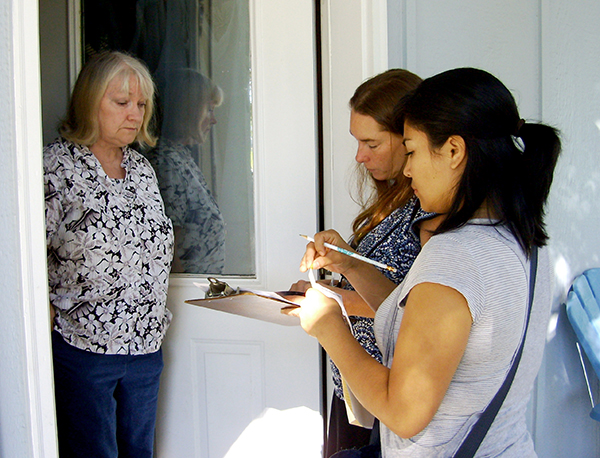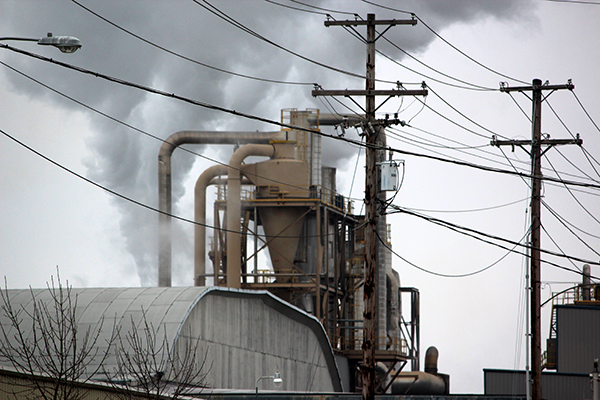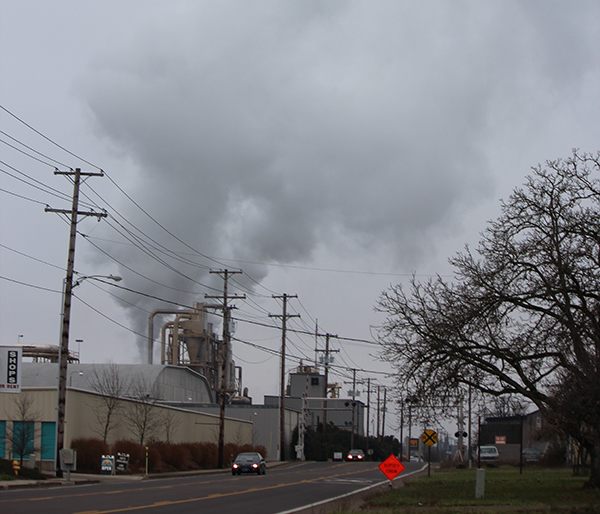
Kylen Tromblay, Summer 2020 intern.
Hello, my name is Kylen Tromblay and I’m an Oregon State University intern at Beyond Toxics this summer. I just finished the first year of my Master of Public Health program specializing in Environmental and Occupational Health. I am passionate about creating a world where everyone can live, work, and play in a clean and safe environment. Having spent the past four summers working with children at a day camp in my hometown of Newberg, Oregon, I get to see the world through their eyes. Seeing how excited the kids are about their own future pushes me to work towards leaving them a healthy Earth.
West Eugene Clean Air Project
Currently I am working with the Beyond Toxics environmental justice team on the West Eugene Clean Air Project. This is an ongoing project investigating how the air pollutants being released affect the health of West Eugene’s community. West Eugene (97402 zip code) is home to an industrial corridor made up of 35 manufacturing companies. All together, 684,159 pounds of toxic chemicals were released into the environment of West Eugene in 2019--that’s 96% of all chemicals being released in the city of Eugene. Many of these industrial facilities are located close to homes and schools in these neighborhoods, leading to ongoing, chronic exposure of toxic chemicals.

Beyond Toxics completed its first information gathering canvassing initiative in 2010.
After years of residents reporting chronic health problems and awful smells in their neighborhoods, Beyond Toxics began collecting information from both residents of West Eugene and other areas of the city to identify commonly reported health problems. The community organizing work undertaken by Beyond Toxics in the past ten years revealed a clear connection between residential proximity to polluting manufacturers and reporting of health problems in Eugene. My intern work has been dedicated to connecting the dots between the health problems experienced by the people of West Eugene and the air pollutants being released into their neighborhoods.
Health Problems Reported in West Eugene
Some of the most commonly reported health concerns in West Eugene included respiratory problems, cancer, and skin rashes. In 2019, manufacturers in the West Eugene Industrial Corridor released 90,557 pounds of acetone into the environment. Research shows acetone inhalation is associated with damage to the lungs and nasal passages in children and adults. For example, a 2003 study found Latinx children exposed to acetone were more likely to report asthma symptoms. Manufacturers also released 34,485 pounds of benzene and benzene containing compounds into West Eugene in 2019. Multiple agencies have classified benzene as a carcinogen (a cancer-causing substance). My investigation found multiple studies to support benzene causing cancers including bone marrow, colorectal, colon, and lung cancer; one study connected mothers’ exposure during pregnancy and an increased risk of leukemia in their children.
Particulate matter (PM) refers to tiny particles that pollute the air and are made up of many different chemicals. Particle pollution can come from different sources, but a common source is air pollutant emissions from manufacturing. My research of a number of published scientific articles showed that people exposed to PM2.5 (fine inhalable particles about 28 times smaller than a strand of hair) were more likely to have skin diseases including atopic dermatitis, eczema and accelerated skin aging.
My investigation also found data to support links between the high levels of diabetes, thyroid disease, high blood pressure, and heart disease being reported in West Eugene. Informed by my extensive literature review, I wonder if the high rates of illnesses reported in West Eugene could be explained by chronic and cumulative exposure to more than ten other toxic chemicals being emitted by manufacturers in the industrial corridor.
Environmental Hazards for Communities of Color and the Working Class
Communities of color and working-class people are more likely to breathe hazardous air pollution; West Eugene reported higher percentages of communities of color compared to the rest of Eugene. The air pollutants emitted by the factories in the industrial corridor affect the health of neighbors in West Eugene. A high percentage of West Eugene residents reported a suspicion of a linkage between their health issues and exposure to toxic soil, air or water. People commonly felt that 1) a toxic smell affected their daily life; 2) their health conditions worsened on days they smelled an odor; and 3) they missed work or school due to difficulties breathing. The people of West Eugene deserve to live in a healthy and clean environment free of the worry that simply living in their neighborhood will make them sick.

This factory sits close the heart of a West Eugene residential neighborhood.
The People of West Eugene Have a Right to a Clean Environment
My research validates the serious worries expressed by the people of West Eugene about the quality of their they breathe. In fact, there is probably even more of a concern than can be measured in the short-term. Many of the health conditions being reported in West Eugene, like cancer, cardiovascular disease, and hypertension can take years before symptoms emerge. Lack of symptoms can result in underreporting of the health problems tied to exposure to toxic chemicals in West Eugene. The people of West Eugene are entitled to have their families grow and enjoy healthy lives without the added stress of air pollution from the industrial corridor harming their health.
~ Kylen Tromblay, Summer 2020 Intern
Sources
Agency for Toxic Substances and Disease Registry. (1994). Public Health Statement: Acetone. | Retrieved from https://www.atsdr.cdc.gov/phs/phs.asp?id=3&tid=1
Buron, G., Hacquemand, R., Pourie ́, G., & Bran, G. (2008). Inhalation exposure to acetone induces selective damage on olfactory neuroepithelium in mice. NeuroToxicology, 30: 114–120
Califf, R. (2008). What Is Heart Disease, What Are The Causes, And How Long Does It Take To Develop? Retrieved from https://abcnews.go.com/Health/HeartDiseaseOverview/story?id=4210085#:~:text=It%20develops%20often%20for%20decades,the%20coronary%20arteries%20has%20already
Centers for Disease Control and Prevention. (2018). Facts about Benzene. Retrieved from https://emergency.cdc.gov/agent/benzene/basics/facts.asp
Cooperman, M. (2020). Beyond Toxics Environmental Community Health Survey
Delfino, R.J., Gong, H.J., Linn, W.S., Pellizzari, E.D., & Hu, Y. (2003). Asthma Symptoms in Hispanic Children and Daily Ambient Exposures to Toxic and Criteria Air Pollutants. Environmental Health Perspectives, 111(4): 647-656
Environmental Protection Agency. (2018). Particulate Matter (PM) Basics. Retrieved from https://www.epa.gov/pm-pollution/particulate-matter-pm-basics#PM
Eugene Toxic Right-to-Know Program. (2020). Material Accounting by Zip Code and Input/Output. Retrieved from https://ceapps.eugene-or.gov/toxics/rptc.asp
Chun, C. (2020). How Long Can You Have Cancer Without Knowing About It? Retrieved from https://www.healthline.com/health/how-long-can-you-have-cancer-without-knowing
Mayo Clinic. (2018). High Blood Pressure (Hypertension). Retrieved from https://www.mayoclinic.org/diseases-conditions/high-blood-pressure/symptoms-causes/syc-20373410
Ngoc, L., Park, D., Lee, Y., & Lee, Y. C. (2017). Systematic Review and Meta-Analysis of Human Skin Diseases Due to Particulate Matter. International journal of environmental research and public health, 14(12):1458
Schnatter, A.R., Glass, D.C., Tang, G., Irons, R.D., & Rushton, L. (2012). Myelodysplastic Syndrome and Benzene Exposure Among Petroleum Workers: An International Pooled Analysis. Journal of the National Cancer Institute, 104:1724-1737
Scientific American. (2012). People in Poor Neighborhoods Breathe More Hazardous Particles. Retrieved from https://www.scientificamerican.com/article/people-poor- neighborhoods-breate-more-hazardous-particles/
Talibov, M., Sormunen, J., Hansen, J., Kjaerheim, K., Martinsen, J., Sparen, Tryggvadottir, L., Weiderpass, E., & Pukkala, E. (2018). Benzene exposure at workplace and risk of colorectal cancer in four Nordic countries. Cancer Epidemiology, 55:156-161
Theis, N. (2020). West Eugene Environment Survey: Health Report
Warden, H., Richardson, H., Richardson, L., Siemiatycki, J., & Ho, V. (2018). Associations between occupational exposure to benzene, toluene and xylene and risk of lung cancer in Montréal. Occupational and Environmental Medicine, 75:696-702
Zhou, Y., Zhang, S., Li, Z., Zhu, J., Bi, Y., Bai, Y, & Wang, H. (2014). Maternal Benzene Exposure during Pregnancy and Risk of Childhood Acute Lymphoblastic Leukemia: A Meta-Analysis of Epidemiologic Studies. PLoS ONE, 9(10): e110466





